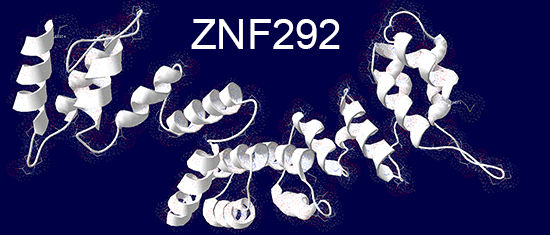 |
HOME CONSERVATION C-TERMINAL ANALYSES DNA AND RNA SEQUENCES RESEARCH QUESTIONS RESULTS RESOURCES REFERENCES |
|
|
|||||||||||||||||||||||||||||||||||||||||||||||||||||||||||||||||||||||||||||||||||||||||||||||||||||||||||||||||||||||||||||||||||||||||||||||||||||||||||||||
|
HP1 Complex
Two protein-protein interaction databases, BioGrid3.5 and IntAct, include interactions between ZNF292 and other proteins including HP-1 components CBX1, CBX3 and CBX5 (Huari 2016). They also found an interaction with SUV39H1, the H3-K9-HTMase. Proximity labeling places ZNF292 near HIST1H3A (Lui 2018). Ostapcuk (2018) Studied the role of ADNP in recruiting HP1 and CHD4. In one of their experiments they immunoprecipitated FlagAviTag-tagged proteins from mouse ES cells. Tagged HP1α (CBX5), HP1β (CBX1) and HP1γ (CBX3) all coprecipitated ZNF292's nearest paralog RLF. HP1γ immunoprecipitated ZNF292 and WIZ - another widely-spaced zinc finger protein. The ADNP-HP1-CHD4 complex may be involved in maintaining distinct cellular states. ADNP like ZNF292 is a C2H2 zinc finger protein, but several of its zinc finger motifs are flagged as non-typical by ProSite Prorule annotation. ADNP also contains a C-terminal homeobox domain. |
|||||||||||||||||||||||||||||||||||||||||||||||||||||||||||||||||||||||||||||||||||||||||||||||||||||||||||||||||||||||||||||||||||||||||||||||||||||||||||||||
Zinc finger proteins interacting with HP-1 from Huari et. al. (2016)
|
|||||||||||||||||||||||||||||||||||||||||||||||||||||||||||||||||||||||||||||||||||||||||||||||||||||||||||||||||||||||||||||||||||||||||||||||||||||||||||||||
|
ILC3 Cells Lui (2017) studied the role of lncKdm2b in the maintenance of ILC3 cells, a key cell in the intestinal response to bacterial infections. They found deletion of lncKdm2b greatly reduced the number of ILC3 cells in the intestines of mice and made them more susceptible to bacterial infections such as Citrobacter Rodentium. As part of their investigation they found that lncKdm2b trans activates ZNF292 by recruiting transcriptional components to it’s promoter. They also reported a ZNF292 -/- mouse which showed sharply reduced ICL3 population. Of interest in the research is the implication that ZNF292 has a role in maintenance of at least one cell type and a mouse ZNF292-/- mouse is viable making it a potnetial model for studying ZNF292 haploinsufficiency's role in neurodevelopmental disorders. |